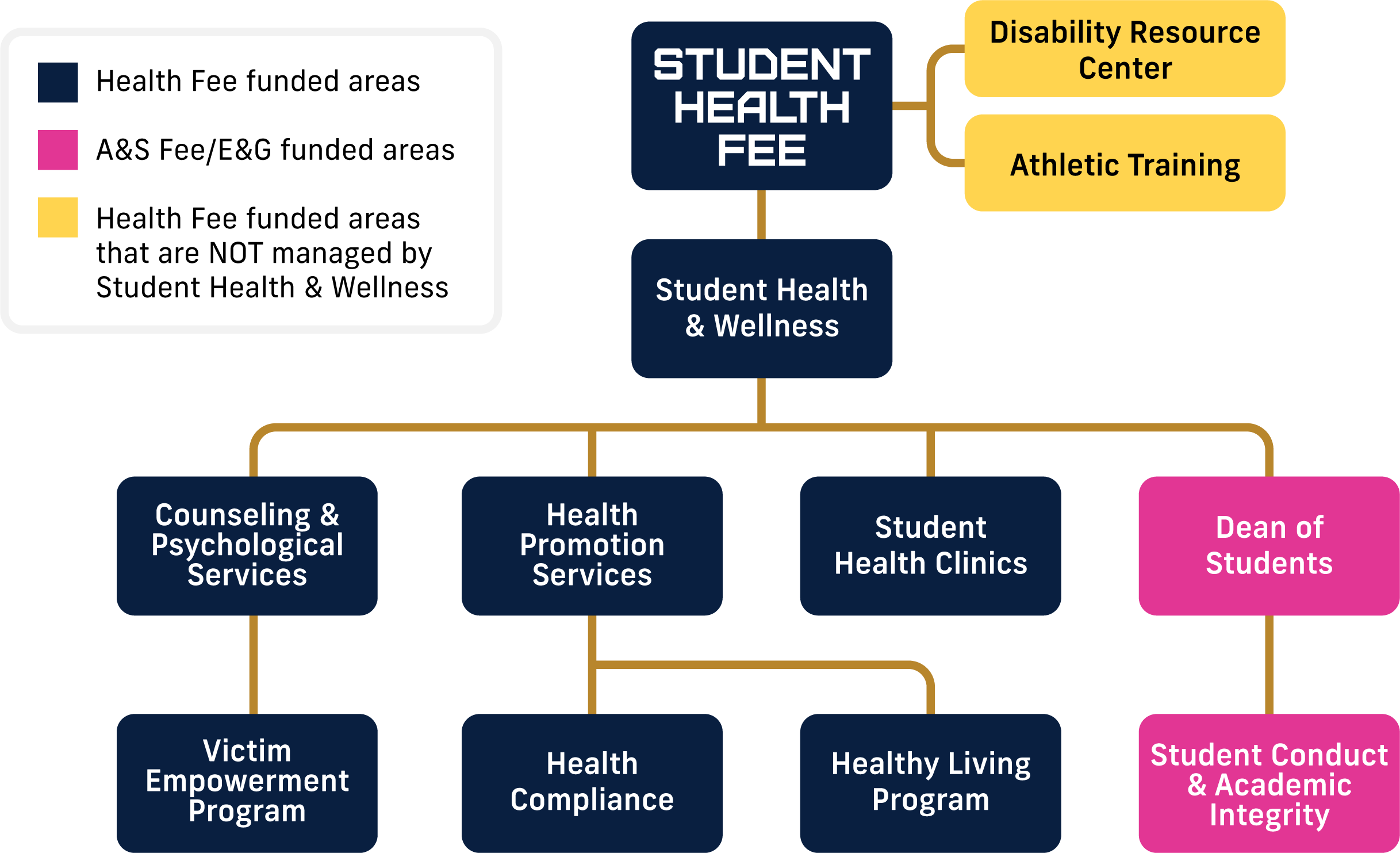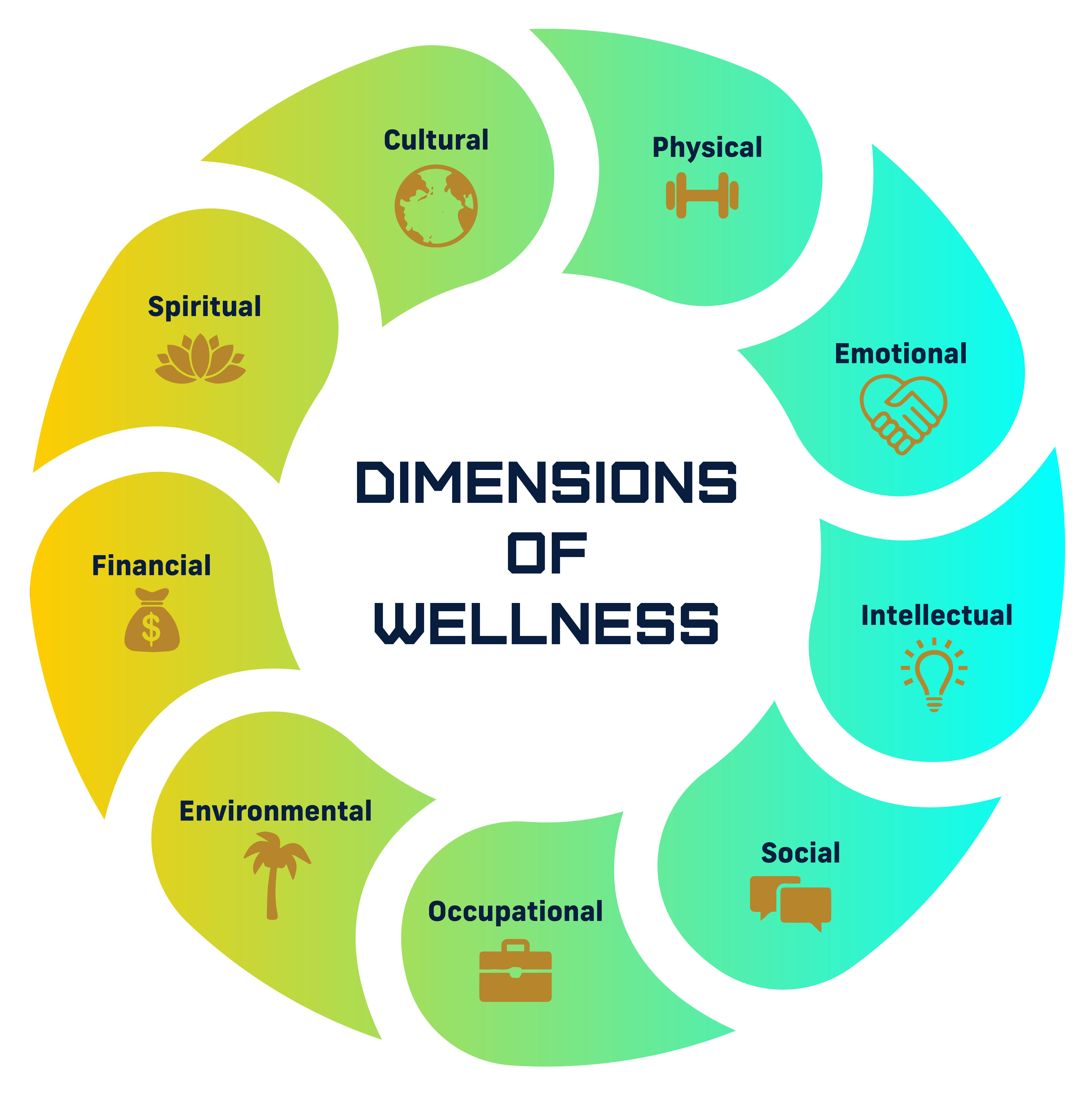FIU Student Health & Wellness (SHW) aims to support the overall well-being of students. We use a multi-faceted approach (i.e., services, programs, trainings, and campaigns) that educates, engages, and empowers the university community to sustain lifelong health and wellness.
Each student at FIU pays $93.69 for the Health Fee each semester they are registered in degree-seeking courses. Those funds, generating an average of $12,000,000, cover costs for the following services:
- Athletic Training
- Counseling & Psychological Services
- Disability Resource Center
- Health Promotion Services
- Student Health Clinics
- Victim Empowerment Program
Outside of those funds, Student Health & Wellness also receives institutional funding to cover additional student support offices like the Panthers Care team and the office of Student Conduct & Academic Integrity as well as educational services like hazing prevention, sexual assault awareness & prevention, and alcohol & other drugs education.
To learn more about SHW’s leadership team, go to the Meet the Staff page.

Guiding Philosophy
In July 2019, our then SVP of Academic & Student Affairs restructured the division into four main pillars – one of those being Student Health & Wellness, which included the following departments: Counseling & Psychological Services; Victim Empowerment Program; Health Promotion Services; Dean of Students; Student Conduct & Academic Integrity. In 2022, SHW expanded to a stand-alone marketing team and the Student Health Clinics. Within this integrated model, we sought a guiding philosophy to lead our work.
Dr. Bill Hettler, co-founder of the National Wellness Institute, created six dimensions of wellness in 1976. As health and wellness services expanded, universities across the country began utilizing the Dimensions of Wellness model to guide their work (with the average wheel highlighting seven dimensions). Given our student population at FIU, we believed it was important to expand the model and include Cultural Wellness. As our team works with students from different ethnicities and identities, it is important that we recognize those unique characteristics that undeniably affect how they seek and utilize our services.
While not all the dimensions are directly managed by our department, it is critical that our team builds partnerships across the institutions so that we can assist students in a holistic manner. For example, we know that if a student has lost their job (occupational wellness) and cannot pay for tuition and basic needs (financial wellness), it can severely impact their mood (emotional wellness) and academic success (intellectual wellness). Working collaboratively and intentionally is how we will best impact student success measures.

Attention must be given to all the dimensions, as neglect of any one over time will adversely affect the others, and ultimately one’s health, well-being, and quality of life. They do not, however, have to be equally balanced. We should aim, instead, to strive for a ‘personal harmony’ that feels most authentic to us.Stoewnn, 2017
Data that Informs Us
In developing the 2024-2027 strategic plan, FIU Student Health & Wellness reviewed relevant research, recently published national reports, utilization data for the last four years, and survey data for the last two years. We strive to:
- Follow guiding international principles like those illustrated in the Okanagan Charter for health promoting universities and colleges.
- Remain informed about national training standards such as those promoted by the Substance Abuse and Mental Health Services Administration (SAMHSA) and accrediting standards such as the American Psychological Association (APA).
- Adhere to best practice approaches provided by the American College Health Association (ACHA), including their Healthy Campus Framework, as well as other national standards provided by NASPA and CAS professional guides.
- Utilize national assessments like the National College Health Assessment (NCHA) and national annual reports like those from the Center for Collegiate Mental Health (CCMH) to evaluate how a range of issues impact our current student population and affect their academic performance.
- Evaluate institutional data and student feedback. We publish all relevant data sets, surveys and reports on our website.
The SHW management team, individually and collectively, also provided input on what the strategic direction for our unit should be.

1. Ethically-driven management
Ethical practices, along with federal, state and institutional regulations, drive much of the work we do. Maintaining those standards is critical in providing a safe, welcoming environment to our students.
- Conduct an assessment for becoming re-accredited by the Accreditation Association for Ambulatory Health Care (AAAHC)
- SHC management will review the AAAHC guidelines needed for accreditation, including, but not limited to: clinical practices; policies and procedures; estimated costs; and governance structure.
- Upon completion of the cost-benefit analysis, SHC management will then make a recommendation to SHW leadership on whether or not to pursue accreditation.
- Encourage and track cultural-competency, trauma-informed, and other relevant trainings for clinical providers.
- CAPS, VEP, HLP, and SHC to review patient experience survey data to identify staff strengths and areas for improvement, related to cultural-competency, trauma informed care, etc.
- CAPS, VEP, HLP and SHC to maximize development by providing different learning opportunities for staff (e.g., conferences, webinars, certificates). Tracking should be managed through PantherSoft HR and the respective supervisors.
- Create and implement an annual, university-wide risk prevention program (e.g., hazing prevention, sexual assault prevention, suicide prevention)
- HLP to delineate institutional partners (e.g., AOD Task Force, FSL, CRCA) and identify any relevant gaps.
- SHW Administration to evaluate current partnerships (e.g., AFSP, NAMI, HPN) and determine which organizations will continue to provide the greatest impact to the student body.
- SHW Administration to hire personnel to manage education, programming, and compliance for these niche topics.
- New hires to utilize pre- and post-survey data, where applicable, from the educational platforms (e.g., Vector Solutions, AliveTek) to determine student learning outcomes.
- New hires to utilize university data (e.g., SCAI) to identify trends of risky behaviors and modify/adapt education and programming to meet the needs of the students.

2. Metrics-guided decision-making
Quantitative data, qualitative data, and assessment standards are important factors for quality care and impactful change.
- Continue to evaluate utilization trends by semester and academic year so that we may adapt operations to meet student demand and expectations (by departments as well as across campuses and modalities)
- SHW units to utilize institutional data (e.g., AIM dashboards, BI dashboards) to understand how enrollment trends could impact services, programs, and marketing techniques.
- Based on both quantitative (e.g., utilization reports, survey responses, budget analyses) and qualitative (e.g., focus groups, survey responses, feedback forms) data, SHW Administration will utilize the Adopt / Adapt / Abandon model to evaluate future services and programs through bi-annual management meetings.
- Create a centralized patient satisfaction survey that would allow for data analysis by department and across units
- CAPS, VEP, HLP and SHC will pilot a consolidated survey for Fall 2023. Based on response rates and how responses are/not being utilized, adjustments will be made for 2024 (e.g., survey name, categories, questions, length, cadence).
- CAPS, VEP, HLP and SHC to work with SHW Marketing on ways to increase response rates (e.g., QR codes at check out, provide incentives).
- Create a long-term plan for data assessment
- SHW Administration to evaluate how data is tracked (i.e., differing dashboards) and evaluated (e.g., utilization, satisfaction) and determine long-term strategies for measurement.
- SHW Administration to follow FIU-APA’s assessment guidelines to create measurable student learning outcomes across all units.
- Relevant SHW units will work with FIU-APA to evaluate correlation, where applicable, of student success measures (e.g., retention, grades, progress towards degree) after utilizing our support services

3. Integrated approach to student care
With all key wellness units now reporting to the same department, we must look at ways to make the student experience (especially for those that use multiple services) as seamless as possible.
- Evaluate the current clinical model, assess which services are most important for students, and identify key recommendations.
- Utilizing the annual student health and wellness survey, SHW Administration & SHW Marketing will assess ways to streamline and improve communication to students about services and programs.
- SHC to evaluate specialty care services for students and determine a sustainable model that offers the best care possible for students while reducing duplication of services (e.g., referral to ACC providers).
- CAPS, VEP, HLP and SHC to evaluate all current testing initiatives (including type, pricing, frequency, duplication, and effectiveness), assess which services are most important for students, and determine which unit will provide the service.
- SHW units to calculate the ROI of current self-help and peer support platforms (e.g., TogetherAll, Kognito), assess which ones have the greatest impact, and publish annual student outcomes.
- Assess the varying functions of clinical operations and identify areas of improved efficiency.
- CAPS, VEP, HLP and SHC to evaluate the medical record systems with relevant clinical partners across the university and identify key recommendations (e.g., EMR, auditing).
- SHW units to create a centralized disclosure form that would allow relevant staff to work collaboratively with students on their care plans.
- SHC and SHW Finance to conduct a cost-benefit analysis of third-party billing for our clinical enterprise.
- Enhance the current case management system.
- Utilizing national standards and peer assessment, DOS, CAPS and SCAI to evaluate the current structure for threat assessment, behavioral intervention, bias response, and care outreach.

4. Centralized approach to operations
With multiple departments across two campuses and several buildings, a unified operational structure can be challenging, but it is necessary for creating efficiencies and increasing the impact on student services.
- Conduct a thorough assessment of the current technology inventory/support system to identify its strengths and weaknesses, and identify key recommendations to streamline support across all SHW units.
- SHW Finance, Student Affairs IT, and SHW IT to work collaboratively on best practices and implement SOPs that will streamline technology requests, inventory tracking, and work orders (e.g., Snipe IT).
- All SHW units to evaluate ways to automate current processes (e.g., docusign, web forms).
- CAPS, VEP, HLP and SHC to evaluate options for and implement HIPAA-, FERPA- and ADA-compliant technology that allows for SMS communication with patients.
- CAPS, VEP, HLP and SHC to assess effectiveness of current appointment scheduling systems and identify key recommendations for improvement/implementation (e.g., online scheduling, reminders).
- Renovate and/or expand the Student Health Center to provide improved clinical areas and more student-centered spaces.
- SHW Administration to evaluate which departments would be best housed within an expanded space.
- SHW Finance to run budgetary scenarios on an expanded space (e.g., increased utility costs).
- SHW Administration to coordinate plans with FIU Facilities.
- Conduct on-going analyses so that SHW budgets are maximized.
- SHW Finance to determine usage of Health Fee fund balance.
- SHW Finance to generate SOP for usage of foundation accounts.
- SHW Administration to seek funding opportunities outside of the Health Fee (e.g., strategic investments, Tech Fee applications, federal grants, donations).

5. Effective outreach and communication strategies
Utilizing multi-modal approaches are critical to reaching as broad an audience as possible. Knowledge and understanding of the latest tools, trends, and social norms will help us stay relevant to the student body.
- Seek and expand opportunities for student feedback.
- SHW Marketing to disseminate an annual student survey each Fall semester. As student demographics and demands change with each new class, survey should be evaluated and edited each year to maximize effectiveness and response rates (e.g., types of services, modality of services, impacts to wellbeing).
- SHW Marketing to create a centralized feedback form to allows students to submit complaints and ideas to SHW leadership. Information received will help SHW units evaluate challenges and improve service delivery.
- SHW Marketing to generate a communication plan for each initiative and campaign (e.g., promoting to SHW employees, cross-marketing from campus partners, cadence for dissemination).
- Evaluate all current educational programming and outreach initiatives to maximize transparency, student participation, and learning outcomes.
- SHW Administration to publish annual reports that highlight service utilization and program impact.
- Update marketing and educational materials in a timely manner, especially when related to updated regulations, policies, and procedures that have an impact on students (e.g., websites, brochures, FAQs, price listings).
- SHW Marketing and HLP to create an annual events and campaigns calendar that would maximize student engagement and eliminate departmental overlap.
- Expand partnerships across the university so that other departments, including employees, understand the available suite of resources for students.
- SHW Marketing to generate a user-friendly guide that encompasses all available health and wellness services for students (both covered and not covered by the Health Fee, and inclusive of university partners).
- Utilizing the information generated from aforementioned goals, SHW Marketing and HLP to determine how best to utilize institutional and community partners (e.g., Faculty Senate, Care Resource).
Acknowledgements
Kudos to all of the hard-working employees of FIU Student Health & Wellness. Your work is critical to the wellbeing and success of our student body, and we thank you for your continued service! (Special thank you to the management team within each SHW unit that was part of preparing this report.)
We would also like to thank the following universities who published their strategic plans online, which provided us with significant guidance while drafting our own: UNC Chapel Hill; Iowa State University; University of Texas; Vanderbilt University.